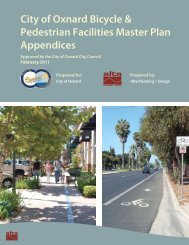Santa Clara River Trail Final Master Plan - Development Services ...
Santa Clara River Trail Final Master Plan - Development Services ...
Santa Clara River Trail Final Master Plan - Development Services ...
Create successful ePaper yourself
Turn your PDF publications into a flip-book with our unique Google optimized e-Paper software.
<strong>Santa</strong> <strong>Clara</strong> <strong>River</strong> <strong>Trail</strong> <strong>Plan</strong><br />
The three categories merely reflect the typical location of gap closure measures (e.g., off-street measures<br />
utilize non-roadway corridors to complete system gaps) and the users of the facility (pedestrians or<br />
bicyclists). In some scenarios, the on- and off-street measures can be used interchangeably to complete<br />
system gaps where necessary. For instance, on-street gap closure measures (e.g., intersection treatments)<br />
may be necessary to complete an off-street path that crosses several major streets with difficult crossings.<br />
Off-Street Gap Closure Measures<br />
The sections below describe shared use path gap closure measures emphasizing off-street treatments.<br />
The measures largely focus on completing off-street walkway/bikeway gaps (e.g., discontinuous path<br />
segments), and are most appropriate for addressing connection, lineal, corridor and system gaps on the<br />
off-street network. It should be noted however that some measures could effectively address some onstreet<br />
walkway or bikeway gaps, especially connection gaps near on-street bikeways (e.g., a<br />
bicycle/pedestrian bridge crossing a freeway to connect an on-street bikeway with a nearby school).<br />
Off-street gap closure methods can include:<br />
<br />
Rails-to-<strong>Trail</strong>s utilize abandoned railroad corridors<br />
to complete shared use path system gaps. Rail<br />
corridors offer several advantages, including<br />
relatively direct routes between major destinations,<br />
and generally flat terrain.<br />
<br />
<br />
Rails-with-<strong>Trail</strong>s typically consist of paths adjacent<br />
to active railroads. Offering the same benefits as<br />
rail-to-trail projects, these projects often have<br />
additional constraints, including a need for space<br />
preservation, limited right-of-way width,<br />
inadequate setbacks, concerns about trespassing,<br />
and numerous mid-block crossings. (Figure 2)<br />
Utility and Waterway Corridor <strong>Trail</strong>s typically<br />
include power line and sewer corridors, as well as<br />
canals, drainage ditches, rivers, and beaches.<br />
These corridors offer excellent transportation and<br />
recreation opportunities for walkers and cyclists<br />
of all ages and skills.<br />
Figure 2. Rail-with-trail along Metro<br />
Orange Line, Los Angeles, CA<br />
Bicycle/pedestrian overcrossings and<br />
undercrossings provide critical non-motorized<br />
system links by joining areas separated by any<br />
number of barriers. Overcrossings and<br />
undercrossings address real or perceived safety<br />
issues by providing users a formalized means for<br />
traversing “problem areas” such as deep canyons,<br />
waterways or major transportation corridors.<br />
Figure 3. Accessways provide connections<br />
through cul-de-sac neighborhoods<br />
City of Oxnard | 39
















